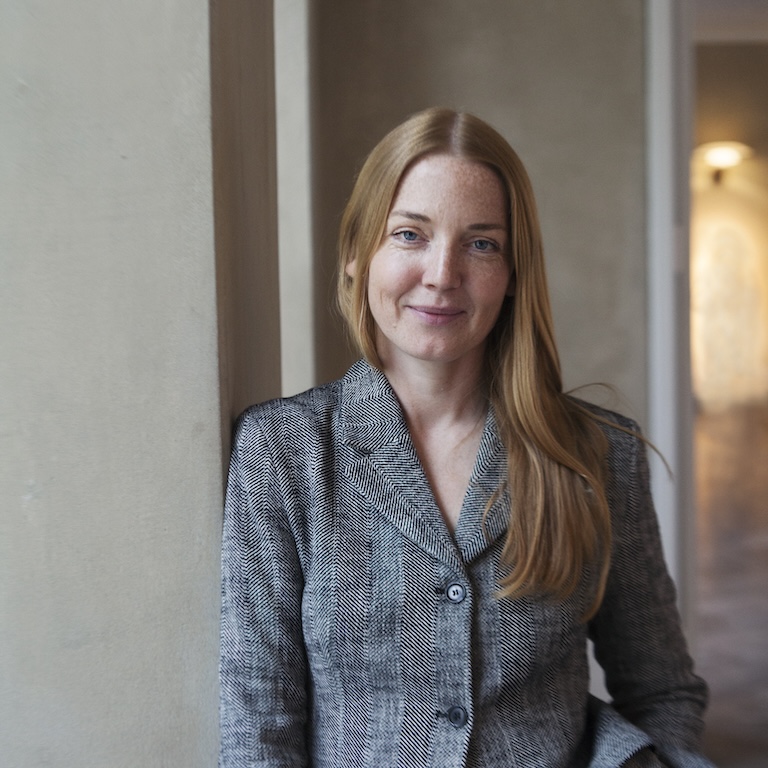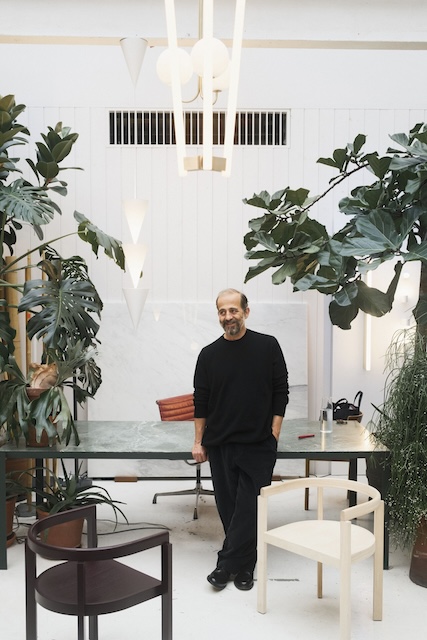OEO Studio
Do you dare to play when there's a lot at stake? Mark Isitt talks to Thomas Lykke, and Anne-Marie Buemann of OEO Studio.
Wow. What a place this is. OK, we know by now that it's important to remember to play, right? But what if you're running an international business with an office in Tokyo as well as here in Copenhagen? And what if your assignments are Michelin-star restaurant interiors, apartments, showrooms, and a hotel in the medieval Modena in Italy? And what if you produced hundreds of objects over this period of almost 20 years; objects, some of them included in the permanent collection of the Victoria and Albert Museum in London?
Do you dare to play when there's that much at stake? Let's ask Thomas Lykke, and Anne-Marie Buemann of OEO Studio. And by the way, neither Thomas nor Anne-Marie are furniture designers or architects by training. So talk about daring.
Mark Isitt: So why play?
Thomas Lykke: I think play is one of the most important elements, actually, and not only as a designer, but actually I think in general, it's very important to be able to play in life. And I think it's important that things are not getting too serious. I think it should be. I mean, it always a balance, of course, with humour. And I mean; we use it a lot in our work. Play and humour to get a more human element into things.
MI: How do you use it?
TL: I think play is many things. Of course, when people think of play, they see small kids playing. And I think it's a little bit the same. I mean, to me, play is also about being curious. I mean, kids are extremely curious, right. And I think many grownups forget to be curious - I can speak for myself; I think it's like this.
It can be the smallest of things. It can become very, very nerdy. It can be walking down the street, and you see something it catches your interest. It can be a pebble on the beach, and it can be a quirky little toy from Shanghai, and whatnot. I think all of these become sources of inspirations.
MI: You've got pebbles from the beach. And you have got quirky toys.
TL: Because we do collect stones, actually. That's because it's obviously shaped by nature. But also, it's the materiality. It can be the texture. It can be intense colours. We use these stones and pebbles. It can be a certain colour, or it can be a certain texture that we want to use. And to catch. It can also be the contrast, in this case, it's the dark versus the white, a little yin yang. So, yeah, there are many elements that are always in play.

MI: Do you regard yourselves as playmates?
TL: Oh, yeah. I mean, we are definitely mates. I guess say playmates as well. Yeah, we are playmates. I think so.
Anne-Marie Buemann: But we have very clearly defined roles, of course, because we have different competencies.
TL: ...but you can still be playmates.
AMB: Exactly. You can still be playmates, but I think it's very much in the initial process, the conceptual phase where we interact, and these discussions pop out of the playing process. And then, when we move further into a project, it's more natural that Thomas is head of design and take over with the creative team. And I take on the project management part of the project.
MI: Do you focus on the result, and is the end result, how your product will be used, or what the effect of your product is going to be? Or is it rather that a product is supposed to look like this - it's the visuals that is important?
TL: The visuals are important. An example could be that we have been working with several craftsmen from Japan, and then how do we take that trade and history - some of them are like 400 years of history - how do we help take them to the next level? So in many cases it becomes much bigger than the actual product. You have to think in a way where it's not only about the product, it's more like the effect it has.
{{pullquote}}
So, in this case, it was also about how we can create something that not only benefits the craftsmen but also and society and the next generations of craftsmen—all these things we had to consider actually when we made Japan Handmade. So of course, that is much bigger than the stool or the vase and so on. It is the impact that is so big. It's very strategic. Strategic play.
MI: That's a nice oxymoron. But is that even possible - strategic play?
TL: Yeah, I think so.
AMB: We always talk about that it's about solving strategic challenges for the brands that we work with—bringing in a new perspective and pushing them. I think we're also very good at challenging our clients, you know, when they come with a brief, we kind of move them and tell them, if we're not sure that it is what you need or what you want.
So I think we are fortunate to have been on amazing journeys with many clients. They have shown us a lot of trust because they couldn't see where we were heading. But they had confidence in the journey and working with us.

MI: Is it a risk to become too playful so the products become lighthearted or a bit silly?
TL: Of course, there's a balance. I don't think we do silly design. I think we are very serious about what we do. But we also like to add a little human touch and humour. I believe that it's very important when creating objects or interiors that people feel welcome and compelled. I think that's something that we are very obsessed about.
And we are not into trends. We are not following trends. We don't find it very interesting, but I think back to being too lighthearted; I think on some specific occasions, it works as well. I think that if we put out all our products, I don't think it would be too playful. But then again, there are elements. It's also challenging what is possible. It could be something with woodworking - that is also a way of playing.
MI: How do you make design communicate?
TL: Yes, that's a very good question. We actually say that design is communication. And so we have something we call compelling communication that's kind of like a mantra.
But how do you do that with an object?
I think you can do that when you're creating design or spaces or interiors where people naturally interact with it more emotionally. If you make a chair, people go from just viewing it to going and feeling and wanting to touch it. Then you have it.
Or if it's interiors and people immediately feel calm and relaxed and want to stay the whole evening then. That is when the space communicates with you, and you feel good. And so, in that sense, you can also translate the chef's vision into it. It can be the colour palette, or it can be the tactility or, you know, all kinds of curated objects.
That is kind of like encapsulating the chef's vision. Or it could be a hotel. It could be many things, but I think it's very much about capturing the human and making people feel welcome. And I think if you can do that, you are communicating. I mean, space can also be extremely cold and clinical. Then it communicates something else - express that either you are dead or in a clinic. You know what I mean.
AMB: Yeah, all the elements that trigger some kind of emotional connection or some kind of emotional reaction.
TL: There's many layers.

MI: What have we got in front of us here on the table?
TL: Well, that's mostly also to show a little process. In front here, we have some experiments. We were working with an American textile company called Ultra Fabrics. We did a showroom for them in London, and we had this idea about how we could show the fabrics in a three-dimensional and more sculptural way.
So we had these vast pieces - these are small - and they were covered with this ultra light bended and then with Ultra Fabrics on it. It had a very sculptural effect and a way to catch light and shadow. It was kind of like an odd installation. It was just like showing process and again showing play.
You have a sheet of metal and you start bending, cutting, bending and then creating, shaping it, and then things take form. So that's again from an idea to something that became a reality from play.
You already saw the Stones, right? So here we have some lamps. There's a prototype from a Danish firm called Anour, where we did this lamp for a hotel in Copenhagen. And then there are just the different stages of prototypes. But as you can see. It's the same vision from the very early designs to the actual product, so it works well. So we are pleased about this product.
MI: You're working in very different scales. From architecture down to jewelry.
TL: Yes, true.

MI: What's the most tricky? When is it most difficult to be playful - in the large or the small scale?
TL: I think it's the same. It does not matter. I think you can be playful in any element, and I think you can do it in a big building or in a small piece of jewelry.
MI: I think that it's a wonder that other design studios don't have this balance of competence. Compared to if you had been two designers, how could you know, as well as you two do, what the client wants and what the client actually has the money to invest in? Because it's this odd mixture that you two make up - it's odd that, it's so odd.
TL: Yeah, we feel very privileged.
AMB: Also because we've been working together for so many years. We have traveled the world, I don't know, so many times. And like you say, we still have a lot of fun and enjoy the work, and it feels very natural. And it's a passion. It's about the passion. Yes, it's about keeping the passion.
MI: And I how do you do that?
TL: Stay curious.
AMB: Stay curious, and continue to not repeat ourselves, but continue to challenge ourselves.
TL: Never rest on our laurels.
At 3daysofdesign, our commitment extends beyond showcasing the latest trends in interior design and furniture. We strive to facilitate meaningful discussions, debate, and actively contribute to pushing forward a more sustainable approach within the realm of interior design and furniture business. Join us in our mission to inspire positive change and promote a greener, more responsible future for the industry.





